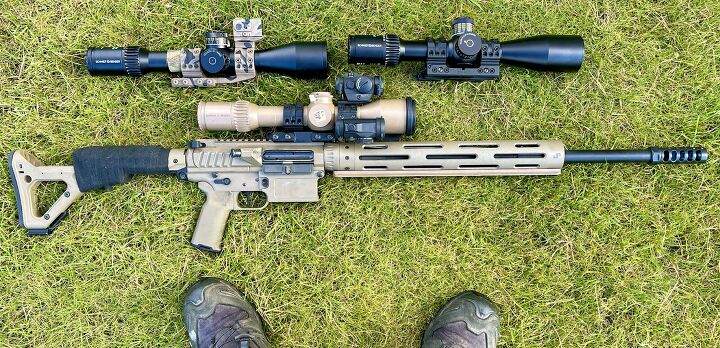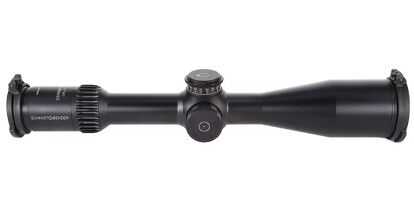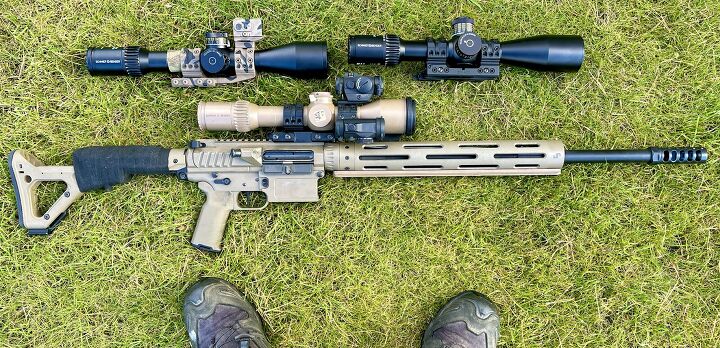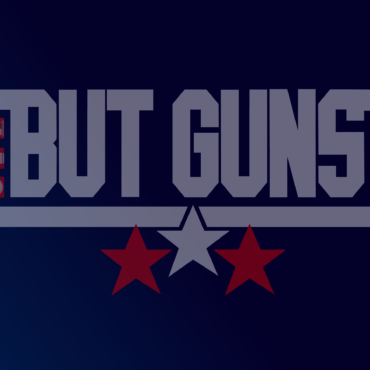TFB Review: Schmidt & Bender 6-36×56 PM II High Performance Riflescope

This is a review of the Schmidt & Bender 6-36×56 PM II riflescope. It is specifically designed for medium to extreme long-range shooting, and has an exceptional field of view. Everything about the design of the new 6-36×56 PM II is pretty traditional and conservative. But who can blame Schmidt & Bender? Their concept is very successful and their optics are famous both for image quality and durability with the best military and police forces on the customer list.
Below: Choices. What should I use for the JP Rifles PCS-12 6.5 Creedmoor?

Below Make 22LR Great Again! S&B 6-36×56 PM II in a Spuhr QD mount, on a Bergara 22LR Trainer, in a MDT ACC Elite Chassis. The tape is to protect the optic from bruises.

If you read this review, you will see that there are some developments here and there. The illumination is now integrated around the main tower, outside the parallax on the left side. The eyepiece is re-worked as well and has grown in size. The result is an amazing sense of “being there, and seeing everything”, combined with an amazing field of view.

Schmidt & Bender Riflescopes @ TFB:

Over the years I’ve tested my fair share of high-end optics, and the Schmidt & Bender 6-36×56 PM II is certainly up there, setting a new benchmark for performance. Designed for long-range precision, this scope delivers in every category that matters: clarity, precision, and reliability. I took one of my S&B 5-25×56 PM II and used it as a benchmark. The new 6-36x was so much better in optical quality, that I first thought my old 5-25x was completely readjusted behind my back. This may sound like an exaggeration, but that was my initial reaction.

Below: S&B have really stepped up, and their packaging is now on a really high level.

Optics and Clarity
The first thing you’ll notice is the optical quality. The 56mm objective lens, paired with Schmidt & Bender’s legendary design and glass, offers exceptional brightness and edge-to-edge clarity. Even at maximum magnification (36x), image distortion is virtually nonexistent—a critical feature when you’re aiming for precision at extended ranges. In low-light conditions, the light transmission is enough for most needs (until you need a thermal). I presume most potential buyers aren’t looking to use it while dark, but it’s still an excellent choice for dusk or dawn shooting scenarios.
Below: 6-36×56 PM II with P5FL. Target is at about 350 meters, and zooming in. Please note that taking images of reticles captures only a fraction of the real quality and sensation.




Below: To compare, here is my S&B 5-25×56 PM II with GR2ID reticle. There is much more tube sensation here.

This is almost a mile away.


I had issues with incoming light from behind, so taking good images of the optics and reticles was not an easy task.

Magnification Range
The 6-36x magnification range is ideal for a variety of applications, from mid-range target shooting to extreme long-range engagements. The flexibility at the lower end ensures you can scan or engage closer targets with ease, while the high end offers the detailed focus required for precision shooting beyond 1,000 yards. Some may have a need to go lower on magnification, but I rarely do this and I often find that the reticles become useless anyway. At 6x, S&B’s reticle is still very usable.

Turrets and Adjustments
The tactile, audible click adjustments on the turrets are among the most precise I’ve ever used, as usual with S&B. Elevation and windage tracking is dead-on accurate, with repeatable adjustments that inspire confidence. The zero stop is robust and easy to set, ensuring you can always return to your baseline quickly and without error. I don’t know any other supplier that has so many turrets and reticles to choose from, and every riflescope is hand-made to your specification (unless you buy from stock of course).
Below: This is from the new 5-20×50 PM II, but you get the idea.

I wouldn’t buy a 1-click 0.5 cm turret, but I can see that some competitors really need it.

New Reticles and Illumination
At the moment, there are four reticle options: P5FL, GR²ID (FFP), TR²ID and M1F. The reticle in this review is the new P5FL. The P5FL is an upgrade of S&B’s well-known P4FL reticle, originally designed for snipers. It offers a clean reticle design, but perhaps too clean for some.
There are already articles on TFB explaining the GR²ID reticle, so I won’t go into deeper detail about it. I have the GR²ID on most of my S&Bs, and would probably have chosen it for my 6-36x if I ordered one (more on that later).
That was until the new TR²ID reticle appeared, and although I haven’t seen or used it, it’s most likely what I’d go for. The key features are, and I quote Schmidt & Bender here:
- “Precise aiming capabilities: Free-floating center-dot for precise shot placement and quick visual acquisition.
- Uniform tree-shape grid: non-cluttered, free-floating dots with 0.2 milliradians subtensions for accurate bullet drop and wind corrections.
- Smart Numbering System: reticle is numbered and clearly marked for easy reference and precise overview in even numbers.”
Below is an image. Please study it and think about how you like it.

The last reticle option is the M1FL, which is a match reticle similar to the LRR-MIL (also previously reviewed here on TFB).
I can only vouch for the P5FL, as it’s the only new reticle I’ve used, but illumination has been crisp and well-designed, with no noticeable haloing, even at higher brightness settings. I like illumination when I shoot, I consider it an asset for all types of shooting.
Build Quality and Durability
I’ve used various Schmidt & Benders for the past 15 years, and to me, they’re synonymous with ruggedness, and this scope is no exception. I use a lot of other brands as well, and S&B is one of the best. The 34mm main tube and construction inspire confidence. It’s built to handle the recoil from heavy calibers and adverse environmental conditions, and their brand can often be seen on guns of a variety of elite units. Waterproofing and nitrogen purging ensure fog-free performance, even in challenging weather.

Real-World Performance
In my testing, the scope performed flawlessly. Unfortunately, I very rarely have access to long-range shooting, but I have no doubts this riflescope is up for it. Spotting impacts and making corrections was effortless due to the clarity and precise tracking, as long as you’re not shooting into a black background with no splash. The scope maintained its zero after repeated adjustments and rough handling during transport.
Here you can see it on the Bergara 22LR Trainer, in the MDT ACC Elite chassis. Shooting steel with this setup is so much fun!
Four rounds of .223 Rem 69 gr GGG Sierra Match King out of my JP Rifles and the 6-36x at 300 meters. It’s a pretty decent result, even if I missed the black patch with 3 rounds.

Check the image below. Although it’s not possible to represent reality in a flat image, you just get “drawn” into the scope, and you get a greatly enhanced image. The last time I experienced something similar was the Swarovski Z6i, which is an LPVO and I use it as my reference optic for LPVOs.

The green light is from the MDT SendIt, electronic level, a great tool.
Even steel hidden in the shadows can be seen with high detail.

As I buy and try a lot of thermals, here’s the Infiray MATE on the S&B 6-36x. 6x is really too high as a minimum in my opinion, at least for my use, but it’s fun to try.

Here’s what it looks like. The optic is looking into the thermal.

Below are some images of the S&B 3-27×56 PM II and the S&B 6-36×56 PM II. The 3-27x has the Aimpoint ACRO and some fancy paint job.




This is the most expensive .22LR I’ve ever shot, but it’s also the most accurate even out to 300+ meters. It’s a RimX 22LR with a Bartlein barrel, 1:14, 60 cm. The chassis is a Spuhr SICS with an adjustable bag rider. Gun maker: Mr. Fabian Wallin. Next stop, the PRS 22 World Shoot in the UK. The mount is a Spuhr QDP-4002.


Below: Top to bottom – S&B 3-27×56 PM II, S&B 6-36×56 PM II and S&B 3-20×50 PM II Ultra Short. As you can see, the 6-36x is fairly compact.

I like “tubes” Made In Germany. The middle one will decrease your eyesight if you have a few, and the glass is of somewhat poor quality.

In terms of price, you’re never going to get out of a premium optic purchase unless you pay the price. In Europe, the price is in the region of EUR 4,200. In the US I found them from about $3,299.99.
Conclusion
The Schmidt & Bender 6-36×56 PM II is undoubtedly a premium riflescope, and its price reflects that. However, for those serious about precision shooting, it’s worth every penny. It delivers confidence-inspiring performance that can make the difference between a hit and a miss at extreme distances.
If precision, reliability, and optical excellence are your priorities, this scope is an investment that will pay dividends every time you’re behind the trigger.

The 6-36×56 PM II you see in this review is a long-term loan from Schmidt & Bender. It has jumped from rifle to rifle, doing its job, and I have just decided to sell one of my 5-25×56 PM IIs and specify a 6-36x to replace it. There are a lot of premium riflescopes to choose from nowadays, but I think the 6-36x should definitely be on your short-list. Try before you buy, don’t always take my word for it.
Below: The legendary 5-25×56 PM II versus the new 6-36×56 PM II.

I don’t really care about the placement of the illumination and other minor improvements that much, but the sheer improvement in the optics department alone is worth it. I am going to put it on my JP Rifles CTR-02 .223 Wylde 18” which I now use for DMR competitions quite actively, and I’m fighting for a place on the podium in the senior category. I’m hoping the new 6-36x will give me that extra edge to get there.
Schmidt & Bender PM II 6-36×56 Riflescopes

You can find a direct link here: https://www.schmidtundbender.de/en/6-36×56-PM-II-High-Performance/163-xxx-xxx-xx-xx
We are committed to finding, researching, and recommending the best products. We earn commissions from purchases you make using the retail links in our product reviews. Learn more about how this works.



